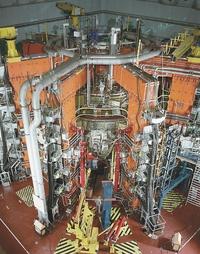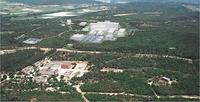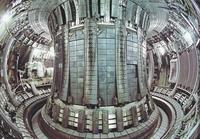By the fusion energy pathways

When they began to investigate the fusion, in the 1920s, the most optimistic said that in twenty years fusion based reactors would be a reality. Reality itself has made it clear that the prediction was too optimistic.
In fusion reactors the nuclei of light atoms, normally the isotopes of hydrogen --deuterium and tritio- join together forming heavier nuclei. In this process a huge energy is released. To achieve this fusion reaction an extreme temperature is necessary: 150 million degrees Celsius.
When the matter is brought to that temperature it is put in plasma state, that is, it becomes hot gas formed by particles with electric charge. This plasma can be stored in a ring shaped reactor surrounded by magnetic fields to prevent it from cooling. The released energy can be used to generate electricity or, for example, to obtain more hydrogen. The hydrogen used in fusion is obtained from the electrolysis of water.

If it is profitable, the melting path can be suitable for cheap, abundant and safe energy. It can remain at any time, closing the fuel tap and ending the reaction. It would also be cheap because deuterium and lithium that would be used as fuel are almost inexhaustible. And it can be said that it is quite clear, because the fusion does not produce gases that increase the greenhouse effect. Only helium is generated, gas used with inflatables.
However, fusion is not entirely clean. Inside the reactor, from lithium, tritium, radioactive gas is generated. The reactor walls, which collect plasma radiations, eventually become radioactive, but experts say that radioactivity disappears at age 50, so it will not be a problem for future generations.
With all these theories, international scientists want to build a prototype that produces energy through fusion: ITER project. The project aims to demonstrate that obtaining energy through fusion is technically and scientifically possible, cost-effective. The reactor will be located in France, in Cadarache, near Aix-en-Provence. After about ten and eleven years, work will begin. The ITER center is the future, but of course it has a background.
Short Mergers

If the search for the past of nuclear fusion is undertaken, the traveler's first stop will be November 1993. That same year, researchers at Princeton University in the United States achieved a power of 5.6 megawatts using the Tokama fusion reactor for research. Two years earlier, however, the British scientific center of Oxfordshire, Culham, was news after knowing that the JET laboratory reached a power of 1.7 megawatts per controlled nuclear fusion. In both cases the amount of energy obtained is not low, but the energy used to obtain it was higher.
The next stop of the backward journey will be the 1960s, when Tokamas began to benefit from the work of machines. Before moving forward, however, it is advisable to take a hole in that station to say at least what that strange name is. It is an instrument born in the Soviet Union, in the form of donuts, formed by electromagnets. Inside matter is transformed into plasma.
After the small break, back back in the 1950s, on the one hand, the invention of the Tokama reactor in the former Soviet Union and on the other, the production of large-scale fusion energy.

The United States, the Soviet Union, Britain and France manufactured and tested thermonuclear weapons in the 1950s. Some of these tests also released fusion energy, undeniable, and in large quantity, being undeniable, but not controlled energy, was a sudden explosion. Obviously, such a process is not adequate to produce energy, electricity.
With a jump that doesn't need much energy, back in the 1930s. It was then that artificial nuclear fusion was first achieved by using a cyclotron or particle accelerator. The natural energy of fusion, the energy of stars, comes from billions of years ago.
And so, suddenly, the journey to the past is over. Currently, the ITER project is the reality, until the project becomes a prototype to be able to build it, in previous works, procedures, business opportunities... Time will tell whether it will be profitable or not.






